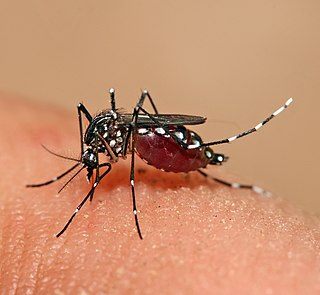
Hordeum is a genus of annual and perennial plants in the grass family. They are native throughout the temperate regions of Africa, Eurasia, and the Americas.

Bacilli is a taxonomic class of bacteria that includes two orders, Bacillales and Lactobacillales, which contain several well-known pathogens such as Bacillus anthracis. Bacilli are almost exclusively gram-positive bacteria.

Aedes is a genus of mosquitoes originally found in tropical and subtropical zones, but now found on all continents except Antarctica. Some species have been spread by human activity: Aedes albopictus, a particularly invasive species, was recently spread to the New World, including the United States, by the used-tire trade.
Luteoviridae is a family of viruses. Plants serve as natural hosts. There are currently 51 species in this family, divided among three genera, with seven unassigned species. Diseases associated with this family include: yellowing symptoms.

Ledum was a genus in the family Ericaceae, including 8 species of evergreen shrubs native to cool temperate and subarctic regions of the Northern Hemisphere and commonly known as Labrador tea. It is now recognised as a subsection of section Rhododendron, subgenus Rhododendron, of the genus Rhododendron.

Alphaproteobacteria is a class of bacteria in the phylum Proteobacteria. Its members are highly diverse and possess few commonalities, but nevertheless share a common ancestor. Like all Proteobacteria, its members are gram-negative and some of its intracellular parasitic members lack peptidoglycan and are consequently gram variable.

Triticeae is a botanical tribe within the subfamily Pooideae of grasses that includes genera with many domesticated species. Major crop genera found in this tribe include wheat, barley, and rye; crops in other genera include some for human consumption, and others used for animal feed or rangeland protection. Among the world's cultivated species, this tribe has some of the most complex genetic histories. An example is bread wheat, which contains the genomes of three species with only one being a wheat Triticum species. Seed storage proteins in the Triticeae are implicated in various food allergies and intolerances.

Hordeum jubatum, with common names foxtail barley, bobtail barley, squirreltail barley, and intermediate barley, is a perennial plant species in the grass family Poaceae. It occurs wild mainly in northern North America and adjacent northeastern Siberia. However, as it escaped often from gardens it can be found worldwide in areas with temperate to warm climates, and is considered a weed in many countries. The species is a polyploid and originated via hybridization of an East Asian Hordeum species with a close but extinct relative of Californian H. brachyantherum. It is grown as an ornamental plant for its attractive inflorescences and when done flowering for its infructescence.

Hordeum murinum, commonly known as wall barley or false barley, is a species of grass.

The Mexican vole is a species of vole.
Methanocaldococcus formerly known as Methanococcus is a genus of coccoid methanogen archaea. They are all mesophiles, except the thermophilic M. thermolithotrophicus and the hyperthermophilic M. jannaschii. The latter was discovered at the base of a “white smoker” chimney at 21°N on the East Pacific Rise and it was the first archaean genome to be completely sequenced, revealing many novel and eukaryote-like elements.

Benyvirus is a genus of viruses, in the family Benyviridae. Plant serve as natural hosts. There are currently four species in this genus including the type species Beet necrotic yellow vein virus. Diseases associated with this genus include: BNYVV: rhizomania.

Barley, a member of the grass family, is a major cereal grain grown in temperate climates globally. It was one of the first cultivated grains, particularly in Eurasia as early as 10,000 years ago. Barley has been used as animal fodder, as a source of fermentable material for beer and certain distilled beverages, and as a component of various health foods. It is used in soups and stews, and in barley bread of various cultures. Barley grains are commonly made into malt in a traditional and ancient method of preparation.

Hemerobius is a genus of lacewings in the family Hemerobiidae. It is found throughout Europe and North America. Like most lacewings, both the larvae and adults are predatory, primarily eating acarines, scale insects, psyllids, aphids, thrips, and the eggs of lepidopterans and whiteflies.
Hypericum aciculare is a shrub in the genus Hypericum, in the section Brathys. It is an accepted name according to The Plant List and Tropicos.
Luteibacter is a genus of Proteobacteria from the family of Rhodanobacteraceae.
Yuyuevirus is a genus of negative-strand RNA viruses which infect invertebrates. Member viruses have bisegmented genomes. It is the only genus in the family Yueviridae, which in turn is the only family in the order Goujianvirales and class Yunchangviricetes. Two species are recognized: Beihai yuyuevirus and Shahe yuyuevirus.

Hordeum secalinum, false rye barley and meadow barley, is a species of wild barley native to Europe, including the Madeiras, Crimea and the north Caucasus, northwest Africa, and the Levant. It has been introduced to Australia and New Zealand. An allotetraploid, it arose from ancestors with the Xa and IHordeum genomes.
Synergus japonicus is a species of gall wasp in the family Cynipidae. Whereas most gall wasps create the galls in which they live, Synergus japonicus is an inquiline species, living in the gall created by another species of wasp. It is native to Japan, China and Russia.











